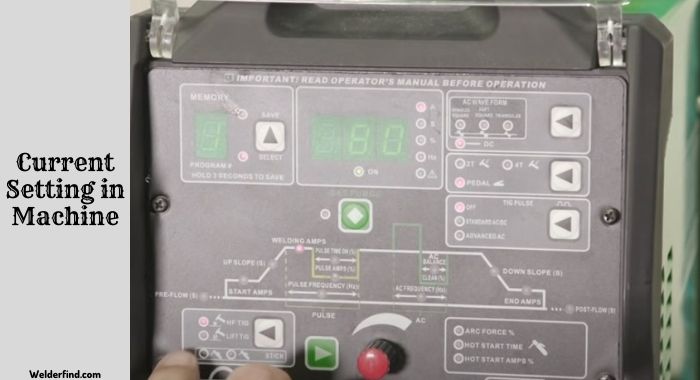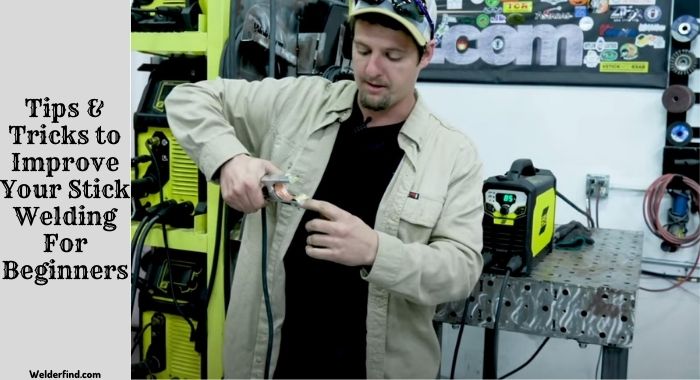Stick welding can be intimidating if you are a beginner in the field of welding. But don’t worry, stick welding is a great way to get started in the world of welding, and you do weld like a pro in no time with a few tricks and trips.
Here we will discuss some stick welding tips for beginners, which will help you get started and improve your skills. You will also get to know the basics of stick welding, risk factors, and things to avoid during welding.
So, let’s get started right away.
What Are The 5 Basic Elements Of Stick Welding Techniques?
Current Setting in Machine

The current setting in the welding machine should be adjusted according to the type of metal you are welding and its thickness. Setting up the machine with the right current setting is crucial in ensuring a successful weld.
Arc Length
Arc length refers to the distance between the electrode tips and your workpiece. Maintaining a proper arc length will ensure the best quality weld and is one of the most crucial factors in stick welding.
The ideal arc length is generally between 3/8 inches to 5/8 inches.
Travel Angle
The travel angle is the angle at which the electrode is moved along the surface joint. You should hold it close to perpendicular to the surface. It will ensure the arc is focused and the welding looks uniform and robust.
Electrode Manipulation
Electrode manipulation is the process of controlling the welding arc to create a strong and consistent bond. The basic principles of electrode manipulation involve holding the electrode at the correct angle, maintaining a proper arc length, and keeping the electrode movement steady.
Travel Speed
It is the speed at which the welder moves the electrode along the joint. You must maintain a consistent travel speed to ensure a clean and consistent weld.
Too fast travel speed can result in poor fusion, and too slow travel speed can cause excessive penetration.
Tips & Tricks to Improve Your Stick Welding For Beginners

Cleanliness Is Key
Cleanliness is crucial to any welding process, as it ensures a smooth and clean welding surface. So, before starting welding, make sure that you clean the area you will weld and the metal you will be working with to prevent any contamination.
Stick Welding Set-Up
You have to set up your welding machine and other accessories with the right settings. Make sure to use the right size electrode, select a proper current setting, use the right electrode angle, try to maintain a constant arc length, and ensure the right travel speed.
Knowing If Your Amps Are Wrong
Knowing if your amps are wrong is a crucial part of stick welding. While too low an amperage can cause lap or lack of penetration, too high of an amperage can result in excessive spatter and distortion.
Remember, the larger the electrode, the more amperage you will need.
Select the Correct Position of Joint and Electrode
When beginning stick welding, one of the most important factors you should ensure is to select the correct position of the joint and electrode.
It can make a massive difference in the quality and strength of the weld.
Make Use of Proper Joint Geometry
Proper joint geometry to the angles at which two pieces of metal are joined. Poor joint geometry can cause an uneven and weak weld.
So, make sure that workpieces are cut precisely to the desired angle to ensure proper joint geometry.
Choose the Correct Electrode
Different electrodes are used for different types of Welding, and choosing the wrong one can lead to poor welding. You have to use mild steel electrodes for welding mild steel, stainless steel electrode for welding stainless steel, and cast-iron electrodes for welding cast iron.
Laying Your First Stick Weld
There are several things you must keep in mind while laying your first stick welding. Firstly, prepare your material and choose the right electrode. Then set the correct voltage and amperage. Use the right technique, pay attention to your speed, and use the right filler material.
Striking the Arc
While striking the ark, your goal is to create a focused spark that will ignite the weld puddle. Starting with a short arc will help you control the spark and get it to the right spot. Also, use a constant motion while striking the arc.
Moving the Stick Electrode
Moving and adjusting the stick electrode will allow you to place the electrode in the desired area and maintain consistent contact with the workpiece. You should keep the electrode moving in a steady and slightly circular motion while keeping the arc length consistent.
Know the Right Arc Length
One of the important aspects all beginners should know is the right arc length. The ideal arc length for most stick welding projects is approximately 1/8 of an inch. You must practice controlling the right arc length to ensure successful welding.
Ideal Travel Angle
The ideal travel angle is the angle at which the electrode travels across the weld joint while welding. Weld can become too shallow and narrow if the travel angle is too steep. But if the angle is too shallow, the weld can become too wide and deep.
Dragging Your Weld
Dragging your weld involves dragging the Stick welding rod along the weld joint while applying current to the rod, and it is an excellent tip for beginner welders. When you drag the rod along the joint, a molten weld will be created, which will help to create a more uniform weld.
Visibility
While stick welding, you must make sure that the place is well-lit. You need to properly see the area you are welding and all the materials. Use a magnifying glass if necessary to get a closer look at the weld.
Avoid Wetness
Moisturizers can cause problems during welding, so always ensure the welding surface is dry. You must also ensure that the work metal is completely dry and moisturizer-free. Wet metal can cause porosity in the weld and make it weak.
What Should You Not Do When Welding?
Welding In a Poorly Ventilated Area
Welding in a poorly ventilated area can cause toxic fumes and particles, which can create major health issues for welders and bystanders.
So, it’s extremely important to ensure proper ventilation while welding. Choose a well-ventilated area, preferably outdoors or in a garage with open doors and windows.
Not Preheating
It is crucial to preheat the material before starting welding. Preheating the joints will reduce the risk of cold cracking. Cold cracking occurs when the welding material cools too quickly and cannot handle rapid cooling. So, you must preheat the materials before welding.
Not Wearing the Appropriate Safety Gear
Welding can be dangerous and cause serious health injury if you fail to take appropriate safety precautions. It is essential to wear protective safety gear, including a welding helmet, face shield, welding gloves, fire-resisting clothes, etc. Not wearing any of these items can lead to severe injury or even death.
Welding On Unstable Surfaces
As a beginner welder, you should always make sure that you are welding on a flat, stable surface, as it will provide you with a better welding result. Welding on an unstable surface can cause the weld to be distorted or weaker. Also, it can cause the weld to shift during the welding process.
Not Cleaning or Maintaining the Arc Welder
When welding, you must make sure that the arc welder is adequately maintained and cleaned. It includes taking the time to inspect the power cord, power supply, and welding cables. You must also clean any dirt, grime, or debris from the welding area.
What Are The 5 Risks In Stick Welding?
Now, let’s check out the 5 biggest risks in stick welding:
- Electric shocks: Stick welding produces high amperage and thus increases the risk of electric shocks.
- Burns: Stick welding produces high temperatures while the welding process, which can cause burns if not careful.
- Fire: Sparks from stick welding can ignite combustible materials and cause fire or blasts.
- Fumes & Gases: Stick welding produces fumes and gases that can be hazardous to breathe.
- Eye Injury: The intense ultraviolet rays and sparks created by stick welding can cause eye injury if you do not take protective eyewear.
Final Thoughts
Stick welding is a handy and important skill to have. As a beginner, it might seem a bit out of your league. But with the right tools, tips, and a little bit of practice, you can learn how to stick welding like a pro.
FAQs
Is welding a hard skill?
Any kind of welding is considered a hard skill as it requires high precision and technical knowledge. You will also need manual dexterity and lots of practice to ace this skill.
What are 3 skills you need for welding?
Welding is a skillful job that requires technical and practical knowledge. You must have many skills for excellent welding outcomes, and among them, the top three skills you must possess are cutting, shielding, and joining.
What is the minimum arc length?
The ideal arc length for stick welding is 3/8 inches to 5/8 inches. Too short or too long arc length can lead to weak and uneven welding.
